 RAN Light protected Cruiser from Cockatoo 1915-22, decom. 1945
RAN Light protected Cruiser from Cockatoo 1915-22, decom. 1945
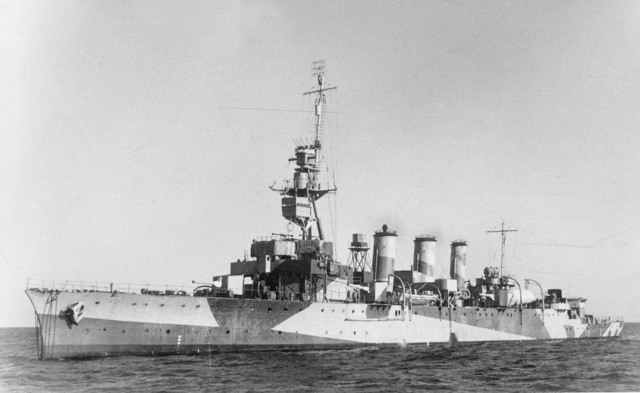
In this new cycle we open the ball of Australian Cruisers, not with the antiquated HMQS Paluma nor with the HMAS Encounter, all transferred ships, nor the battlecruiser Australia, cruisers Sydney and Melbourne on 1918, but with the second cruiser actually built in Australia, HMAS Adelaide. As nickamed, “HMAS Londelayed” was indeed based on a successful prewar design, the “Town class” (Sub-classes Chatham/Birmingham), and it was decided for Cockatoo shipyard to contribute to the collective industrial effort of the Commonwealth with such ship, laid down in 1916, launched in 1918, but with the war over, only completed by 1922. She missed WWI by a long shot, but was present in WW2 and soldiered on with an interesting career until 1945.
Development
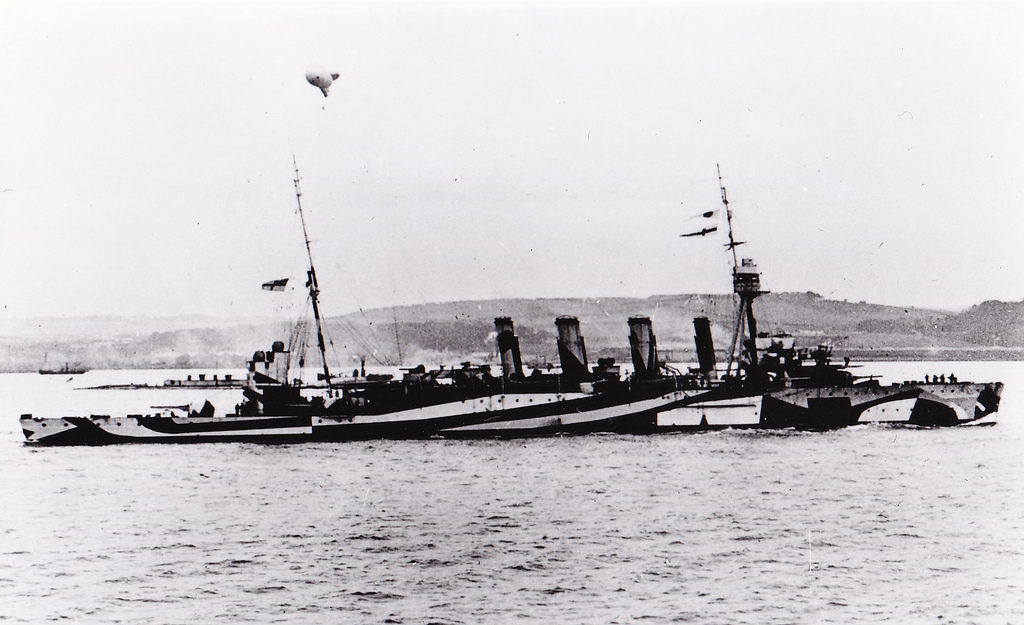
HMAS Melbourne camouflaged in 1918, apparently the only Australian cruiser to receive a ww1 style dazzle livery.
The “Town” class is a superclass of 22 light cruisers (“light” only in post-Washington classification) which all shared similar dimensions and characteristics but were ordered over time in different yards and thus, was further divided into the sub-classes Bristol, Weymouth, Chatham, Birmingham, and Birkenhead. Among these were already three Australian cruisers in class, HMAS Sydney, the executioner of Emden in 1914, HMAS Melbourne and HMAS Brisbane, part of the Chatham sub-class comprised six protected cruisers, including Chatham, Dublin, and Southampton.
Indeed the order was ordered to be split between the Royal Navy and the Australian Navy, one programmed to be even built in an Australia yard, HMAS Brisbane. Ordered under the 1910–1911 Programme the five British Yards completed each a vessel in 1912 and 1913, HMAS Brisbane being laid down in 1913 at Cockatoo shipyard and only completed in 1916. This first cruiser ever built in Australia was to be instrumental for more constructions to follow, providing an invaluable experience.
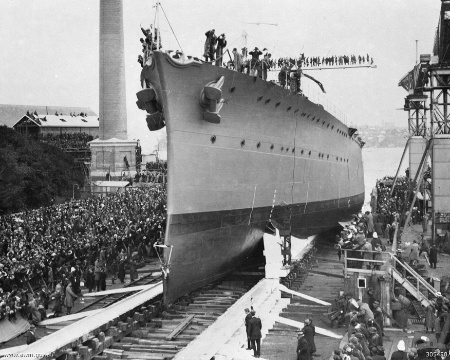 Indeed, with the next Birmingham class Cruisers (1913), of the 1911–1912 Programme comprised three ships completed in 1914 followed by a fourth to be built by and for Australia, HMAS Adelaide.
Indeed, with the next Birmingham class Cruisers (1913), of the 1911–1912 Programme comprised three ships completed in 1914 followed by a fourth to be built by and for Australia, HMAS Adelaide.
The Birmingham class were closely based on the Chathams but with a revised armament by mounting two guns side-by side on the forecastle which by the way had increased flare to reduce spray. There were nine BL 6 inch Mk XII guns total, which was good for their displacement. The light artillery was left unchanged and they were all capable of 25.5 knots, having still an excellent protection. In 1915, a 3-inch AA gun was added as well as new director control on the British ships. The case of HMAS Adelaide however was different. Being in service so late (see later) Adelaide received the same upgrades after completion in 1922, but was completely overhauled and refitted in 1933 and ended as a very different animal.
The design of Adelaide was not “stock” but modified from the Chatham sub-class with strong similarities to the Birmingham subclass. She was to be an in-between and ended significantly larger overall than both.
She was laid down at the Cockatoo Island Dockyard in Sydney, on 20 November 1915. It was part of the network of “Royal Dockyards” established to take care of British warships operating in the area. It was established in 1857 to maintain Royal Navy warships at first in drydock, and was later extended and massively upgraded to repair and maintain battleships, playing a key role in sustaining the Royal Australian Navy and notably it’s largerst assets. Indeed it was puchased by the Commonwealth from the New South Wales Government in 1913, and built over 50 ships, repaired or converted more than 150 by 1918. By December 1919 the yard’s workforce was 4,085. The post-1929 crisis led to lease the yard as the private Cockatoo Docks & Engineering Company in 1935. In WW2 the yard became main ship repair base in the South Pacific after the Fall of Singapore with 19 new ships built and major repairs on 40 Allied warships. It was closed in 1991, but its remnants are heritage were listed in the Cockatoo Island Industrial Conservation Area.
HMAS Adelaide was launched on 27 July 1918 by Lady Helen Munro Ferguson, wife of the Governor-General of Australia, Sir Ronald Munro Ferguson. Construction however dragged on because in that time, parts came from UK and took ferever to arrive, as well as wartime shortages, and the loss of machinery part forgings, inclduing for items that could not be made in Australia, to enemy action (U-Boat sinkings). There were also modifications based on wartime experience. For all this, she was not completed until 31 July 1922 and consequently nicknamed “HMAS Longdelayed”. She was commissioned into the RAN on 5 August 1922 at a final cost 1,271,782 pounds to build, something eye-watering compared to the previous HMAS melbourne.
Design of the class
Hull and general design
The HMAS Adelaide ended with diverging specs, perhaps confused with those of her 1933 reconstruction. She displaced 5,560 long tons (5,650 t) fully loaded, based on a waterline length of 138.8 m (455 ft) and 462 feet 6.5 inches (140.983 m) overall or 430 feet (130 m) between perpendiculars. Her beam was 49 feet 9.5 inches (15.177 m) and not 14.9 m (49 ft) and her draught 19.66 feet (5.99 m) instead of 5.7 m (19 ft). Otherwise her design was very close to the Town class, with four funnels a foremast and smaller aft mast, raked like her four funnels, spotting top and a searchlight, and another searchlight aft. The armament configuration followed her other sisters design, except modernized and adapted (see later).
Protection
It differed little from the original Chatham-Birmingham design. She had a full armoured belt for the whole length of the hull 3 inches thick 76mm abreast the machinery spaces and 2 inches (51 mm) at both ends. It also extended vertically to her main deck and to the upper deck abreast machinery to create a turtleback as customary for protected cruisers. This sloped protective deck was 0.7 inches or 19mm thick over the machinery and 1.5 inches (38mm) over her steering gear. Remaining protection thickness overall was 0.4 inches or 10 mm, mostly in the hull, participating in the overall rigidity. Superstructures were likely thinner. The gun shields were probably no more than 0.3 inches thick as well, offering some protection against light splinters and small arms fire.
Powerplant
The propulsion system consisted of two Parsons turbines fed by 12 Yarrow boilers providing 25,000 to 25,500 shaft horsepower (19,000 kW) driving two propeller shafts fopr a top speed as designed of 25 knots (46 km/h; 29 mph) or 25.5 as seen in some sources. She originally had boilers fuelled by both coal and oil, with 860t coal and 550t oil for 4,140 nautical miles at 16 knots in range.
This was modified after her reconstruction of 1933.
Armament
Being based on a near-repeat of the Chatham class her alterations consisted in a second 152mm on the forecastle, a pair to improve ahead fire, but also additional flare of the forecastle, to reduce water spray. All her main guns were the new 45 caliber 6 inches or 152mm guns. She also had some additions of her own.
6-inches/45 BL Mk XII
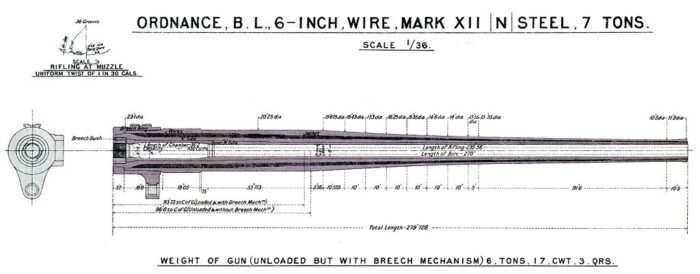
The last and best intermediate naval gun of the RN, in service until… 2011. Designed in 1913, 463 were manufactured until 1918 by Vickers. It was widespread and took part in two wars as well as the cold war.
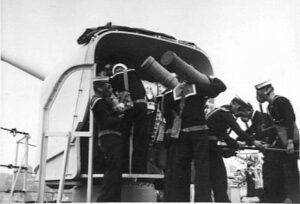 Weight 15,512 pounds (7,036 kg) barrel & breech for 270 inches (6.858 m) bore, exact caliber 152.4 mm.
Weight 15,512 pounds (7,036 kg) barrel & breech for 270 inches (6.858 m) bore, exact caliber 152.4 mm.
Breech: Welin interrupted screw with Hydro-spring 16.5 inches (420 mm) recoil
Pivot mount elevation −7°–30°
Shell: 100 pounds (45.36 kg) filled Lyddite, AP with Shrapnel, muzzle velocity 2,825 fps (861 m/s)
Rate of fire 5-7 rpm, Max range 19,660 metres (21,500 yd).
Photo: Gun crew training in gas masks, 1939 (IWM)
QF 3-inch 20 cwt QF Mk I
Single standard AA gun, installed aft of the funnels.
Fired a Fixed QF HE 76.2 × 420 mm R, 16 lb (7.3 kg) model 1916 76 mm.
Breech: Semi-automatic sliding-block, 11 inches (280 mm) hydro spring recoil, 90° elevation
16–18 rpm rpm, mv 2,000 ft/s (610 m/s) for the 16 lb (7.3 kg) shell
Effective range 16,000 ft (4,900 m), max 22,000 ft (6,700 m) with the 16 lb shell.
QF 12-pounder 8 cwt gun, 3-inch/40 (76.2 mm)
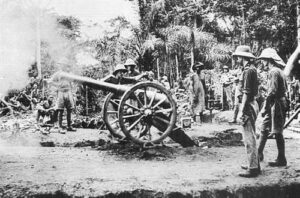 She also had the Ordnance QF 12-pounder 8 cwt was a Royal Navy “landing gun” intended to be used ashore with landing parties. It had a wheeled undercarriage.
She also had the Ordnance QF 12-pounder 8 cwt was a Royal Navy “landing gun” intended to be used ashore with landing parties. It had a wheeled undercarriage.
In short, 84-inch (2.1 m) bore, 28 calibres, firing a Separate QF shell 12.5 pounds (5.67 kg) Shrapnel, Common Lyddite (mv 1,585 feet per second or 483 m/s), max range 5,100 yards (4,660 m)
.303-inch machine guns
She also came out with ten Vickers liquid-cooled .303-inch (7.7 mm) machine guns. It is unclear how they were distributed, likely on removable pivots mounts, but were certainly planned to be used with landing parties alongside the 12 pdr wheeled gun. Most sources states she also had four 47mm/40 3pdr Hotchkiss Mk I. These were not intended for combat but usable as saluting guns, with low velocity. It is assumed they could have been landed as well and used to fire smoke shells.
Torpedo Tubes
Like other cruisers of the class, and unlike more modern design fitted with banks of torpedo tubes she had two fixed ones in the broadside, underwater (under the belt).
The torpedo types fired were likely the Vickers late Mark IV* torpedo:
Weight: 3,200 lb (1,400–1,500 kg) for 22 ft 5 in (6.83 m) long
Explosive charge: 500 lb (230 kg) TNT
Range and speed: 4,500 yd (4,100 m) at 44.5 kn (82.4 km/h), 6,000 yd (5,500 m) at 35 kn (65 km/h), 11,000 yd (10,000 m) at 29 kn (54 km/h), 15,000 yd (14,000 m) at 25 kn (46 km/h), 18,000 yd (16,000 m) at 21 kn (39 km/h)
Improved gyro control gear, outfitted at the factory with either the 44.5-knot or 35-knot high speed setting.
⚙ specifications 1922 |
|
| Displacement | 5,400 long tons (5,480 t) |
| Dimensions | 138.8 x 14.9 x 5.7m (455 x 49 x19 ft) |
| Propulsion | 2 shafts, 3 Parsons turbines, 12 Yarrow boilers, 25,000 shp (19,000 kW) |
| Speed | 25.5 knots (46.3 km/h; 28.8 mph) |
| Range | 4,460 nautical miles (8,260 km; 5,130 mi) at 10 knots |
| Armament | 9x 6-in Mk XII, 1x 12 pdr 8cwt, 4x QF 3-pdr saluting, 1x 3-in AA, 10 MGs, 2× 21 in TTs, 2 DCT |
| Protection | Belt 3 in (7.6 mm) amidships, deck 0.375–1.5 in (9.5–38.1 mm), CT 4 in (102 mm) |
| Crew | 33 officers and 450 sailors |
1938-43 Modernizations, Reconstructions and Upgrades
At that stage it was clear that the design of HMAS Adelaide was obsolete. Times were those of dual purpose guns, deck torpedo tbes banks, and twin turrets. Australia was just about to receive three brand new cruisers of the Perth class, based on a 1931 light British design (Leander class). Adelaide was not on par with them, her guns were still good, but her fire control system obsolete and she was much slower comlpared to their 32.5 knots. Plus they were large enough at 9,500 tonnes FL to carry and operate a Walrus reconnaissance seaplane. Adelaide was planed in reserve at the time as the crisis hit badly the Australian economy.
However with the geopolitical situation degrading in the far east, notably after the invasion of China (second sino-Japanese war), it was decided to reactive the cruiser and modernize her locally from 1937 onwards. That year she had her 3-in/40 AA gun removed. In early 1938 until March 1939 with the prospect of war looming she was taken in drydcok at Cockatoo for a more comprhensive reconstruction. Her powerplant was converted to oil only (assumed to be more modern boilers as well), and she lost her foremost funnel and corresponding two boilers. Her top speed was probably aroj d 24.3 knots on average, still listed at 24.8 knots (45.9 km/h; 28.5 mph) by 1941 based on 23,500 hp. Fuel stowage was now 1,420t of oil. Range likely augmented, but she was not intended for fleet actions and instead mostly convoy escort work.
Armaments wise, she lost a 152mm/45 and her two beam torpedo tubes. In deplacement, three 4 inches or 102mm/45 QF Mk V dual purpose guns were installed to increase AA. It is very likely that her Vickers MGs, wheeled 12-pdr field gun were removed as well. She still lacked AA at this point. The Fire-control equipment was also upgraded at this time.
In July 1942 she received at last six 20/70 Oerlikon Mk II/IV and a type 271 radar at the same occasion.
By September 1943, after another refit, she had another main gun landed plus one of her 4-in/45 DP guns to make room for four hydraulic Depht Charge Thrower at the poop for ASW work, as well as a type 285 replacing her 271 surveillance radar and the US SC radar, but no AA addition. To also regain stability it seems all main guns had their heavy cast shield removed and replaced by lightweight welded ones. The bridge was also considerably beffed up and enlarged, and her formast became a more solid tripod supporting extra platforms and spotting tops. The rear structure was modified and gained extra platforms for two searchlights.
⚙ specifications WW2 |
|
| Displacement | 5,560 long tons (5,650 t) |
| Propulsion | 2 shafts, 2 Parsons steam turbines, 8 boilers: 23,500 hp |
| Speed | 24.3 knots |
| Range | Unknown, c4500 nm/16 knots |
| Armament (1943) | 7x 6-in/45, 2x 4-in/45 DP, 6x 20 mm Oerlikon AA, 2 DCTs |
| Sensors | type 271, then Type 285, SC radars. |
| Crew | 26 officers and 436 sailors |
Career of HMAS Adelaide
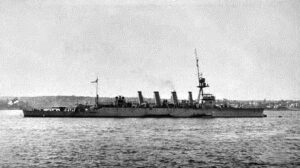 After a sea trials, she worked the crew off Jervis Bay, and trained until February 1924 with fleet exercises within the Australia Station. On 18 April 1924, she had a brief refit, and joined the Royal Navy’s Special Service Squadron for a flag-showing cruise in Asia. HMAS Adelaide visited New Zealand, but also Fiji and the USN base in Hawaii, and also the northwards to the western coasts of Canada and the US. The fleet crossed the Panama Canal (she became the first RAN ship doing so) and ended in the Caribbean, travelled north along the US east coast and new englad, and arrived at Newfoundland, then sailed to Portsmouth on 28 September. She stayed in UK until 10 January 1925, via the Mediterranean, passed the Suez canal, stopped in Ceylon, Singapore, and Thursday Island before reachingSydney on 7 April, concluding her first and only world tour.
After a sea trials, she worked the crew off Jervis Bay, and trained until February 1924 with fleet exercises within the Australia Station. On 18 April 1924, she had a brief refit, and joined the Royal Navy’s Special Service Squadron for a flag-showing cruise in Asia. HMAS Adelaide visited New Zealand, but also Fiji and the USN base in Hawaii, and also the northwards to the western coasts of Canada and the US. The fleet crossed the Panama Canal (she became the first RAN ship doing so) and ended in the Caribbean, travelled north along the US east coast and new englad, and arrived at Newfoundland, then sailed to Portsmouth on 28 September. She stayed in UK until 10 January 1925, via the Mediterranean, passed the Suez canal, stopped in Ceylon, Singapore, and Thursday Island before reachingSydney on 7 April, concluding her first and only world tour.
In October 1927, she was ordered to sail for the Solomon Islands after the killing of a district officer as well as a cadet, and fifteen native police in the hands of Kwaio natives, in the what was the insurrection of Malaita. She arrived at Tulagi on 14 October with an extra officer plus sixteen sailors armed for a landing party and sent ashore to join the local law enforcement until the situaiton calemd down. The cruise later entered Malaita, bearing guns to cover the landing of three platoons on 17 October. She remained there to provide on demand gunnery support and until the end of the Malaita massacre’s resolution. She sailed back to Australia on 23 November and returned to her exercises routing, with promotional visits to various Australian ports (she was not the sole remaining Australian cruiser at this point, with HMAS Melbourne still in activity.
However both her and Adelaide were paid off into reserve. Melbourne o, 9 February and Adelaide on 27 June 1928. Unlike Melborne, which returned to UK and was paiod off in April, then sold for BU in 1929, Adelaide being built by Asutrlian remained government’s property. She remained in reserve until 1937, reactivated, with some alteration made (see above). She had her major refit and reconstruction in 1938 and 1939 at a cost of 60,000 pound and was officially recommissioned on 13 March 1939. She resumed exercises with the Australian and New Zealand Squadrons, but was foud slow compared to the other cruisers (almost 10 knots difference !), limiting her usefulness. She was in Sydney in late April, paid off again on 17 May to free the crew, sent to England aboard SS Autolycus to commission the new HMAS Perth, former HMS Perth after a transfer decision. However as war was looming at the horizon, it was decided to recommission the ship and raise a new crew. She was recommissioned for the last time on 1 September as the war broke out in Europe.
Given her limited capabilities she was automatically assigned to convoy escort and protection duties, in Australian waters.
In September 1940, she carried the French official Henri Sautot from the New Hebrides (later Vanuatu) to Nouméa in New Caledonia, just appointed governor by Free French leader Charles de Gaulle. Indeed, Vichy France attempted previously to gain control of the colony, a large island rich with minerals, notably bauxite used for aluminium production. On 3 September she collided en route by night and poor visibility with the merchant vessel SS Coptic. Both ships suffered minor damage but the Shaw, Savill & Albion Line nevertheless sued the Australian government after the war, in 1947, for £35,000 in damages. Sautot landed in Nouméa on 25 September and she started to patrol off the coast, as it was known the Vichy sloop Dumont d’Urville was in the vicinity and mmioght attempt to retake the city. The Australian cruiser remained there until the situation stabilised and returning to Sydney on 8 October. This was important as New Caledonia soon became vital rear base for operations in the Solomons, and win the Guadalcanal Campaign. Conversely of fell into Vichy hands, it could have been used to resupply U-Boats and Japanese submarines. That fear led to Operation ironclad against Madagascar in 1942.
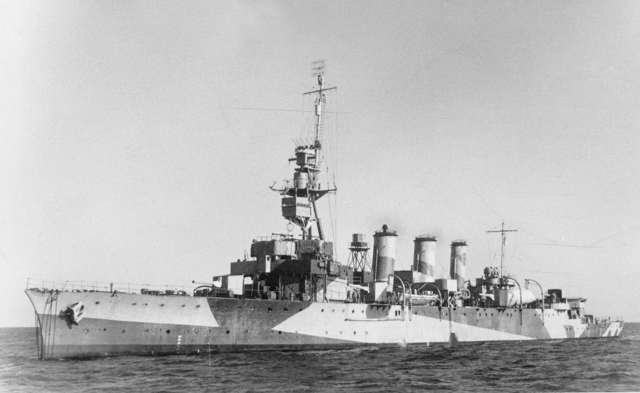
HMAS Adelaide in 1942 in the typical Mediterranean camouflage
Adelaide resumed escort/patrol work around Australia and soon in New Guinea waters. From May to July 1942, she was refitted at Garden Island, gaining Oerlikon anti-aircraft cannons. She was present in Sydney Harbour as a Japanese midget submarine attack took place on 31 May 1942. Next she was assigned to Fremantle and resumed convoy escort work in the Indian Ocean. In November 1942, she teamed up with Dutch cruiser HNLMS Jacob van Heemskerk and RAN corvettes Cessnock and Toowoomba to escorted an important convoy via the southern Indian Ocean. On 28 November they spotted an unidentified vessel, which passed for the Norwegian merchantman Taiyang but the captain and officers on board Adelaide recognised the German blockade runner Ramses. They challenged her, obtained no response, and prepared for combat. Two boats were eventually lowered followed by a detonation, as the German crew decided they were no match (Blockade runners were generally poorly armed wompared to AMCs) and decided to scuttling her instead. Adelaide opened fire nevertheless on the ship, and pumelled her until she sank eight minutes later but recovered the Germans crews. The gunnery display was as much for training and to ensure the cargo would be of no use for anyone. The convoy resumed and ended without a hitch. She went back to Australia afterwards.
HMAS Adelaide continued to operate from Fremantle until October 1944, after a refit at Williamstown Naval Dockyard (June-September 1943). On 8 October 1944, she headed for Sydney, remained inactive seemingly to free crews for other ships, notably new destroyers, and on 26 February 1945 she was decommissioned, recommissioned on 19 May with a sekelton crew to act as tender to the naval base HMAS Penguin. When decommissioned for good on 13 May 1946 she was awarded the battle honours “Pacific 1941–43” and “East Indies 1942”.

HMS Adelaide in 1944, note the new camouflage, and her radars.
Next, she was stripped of equipment in 1947. On 24 January 1949 she was sold to Australian Iron and Steel and towed by the tug HMAS Reserve to Port Kembla on 1-2 April for scrapping. Her main-mast survived and was erected at the Sphynx Memorial, Ku-ring-gai Chase National Park in Sydney around 1950 with an information plaque feturing a diagram. On of her 6-inch guns ended in a rubbish tip in Victoria but was restored, and is now on display at HMAS Cerberus base in Victoria. Her bell ended in the Amazon Hotel in Exeter, UK, then the Spice Lounge restaurant in Exmouth.
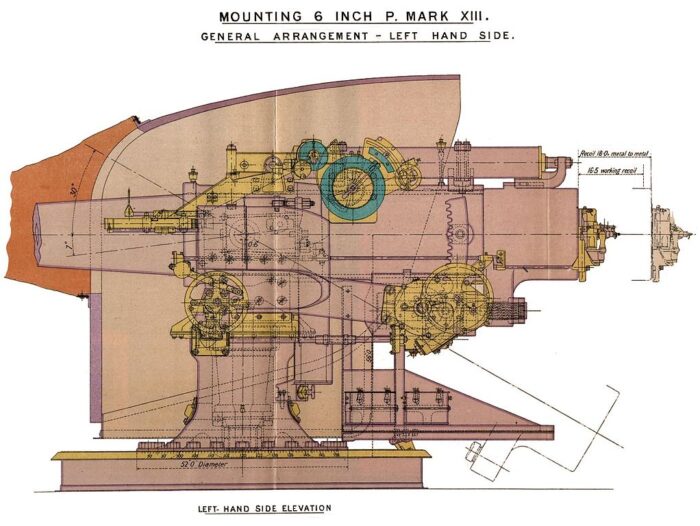
A gun shield removed in the 1943 refit was found in Mornington Peninsula (Victoria) and transported to Perth, refurbished. It ended covering a gun from HMAS Sydney (scrapped 1928) now on display at Leighton Battery since 2015.
Read More/Src
Books
Cassells, Vic (2000). The Capital Ships: Their Battles and Their Badges. East Roseville, NSW: Simon & Schuster.
Gillett, Ross (1977). Warships of Australia. MacDougall, Anthony; Graham, Colin (illustrations). Adelaide, SA: Rigby.
Jenkins, David (1992). Battle Surface! Japan’s Submarine War Against Australia 1942–44. Milsons Point: Random House Australia.
Links
Perryman, John (July 2015). “Ships Named Adelaide” (PDF). Semaphore. 2015 (4). Sea Power Centre – Australia.
on navypedia.org/
on commons.wikimedia.org

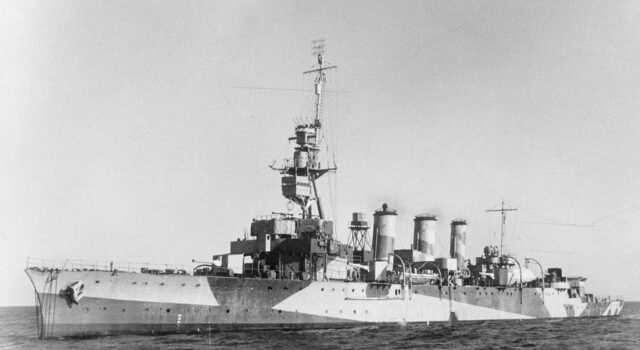
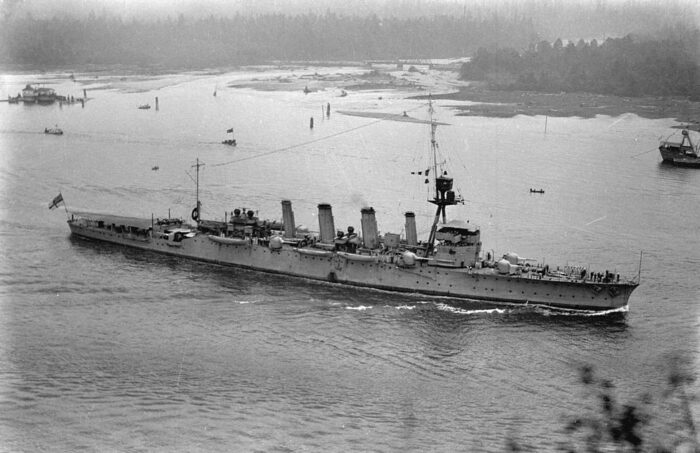
 Latest Facebook Entry -
Latest Facebook Entry -  X(Tweeter) Naval Encyclopedia's deck archive
X(Tweeter) Naval Encyclopedia's deck archive Instagram (@navalencyc)
Instagram (@navalencyc)





 French Navy
French Navy Royal Navy
Royal Navy Russian Navy
Russian Navy Armada Espanola
Armada Espanola Austrian Navy
Austrian Navy K.u.K. Kriegsmarine
K.u.K. Kriegsmarine Dansk Marine
Dansk Marine Nautiko Hellenon
Nautiko Hellenon Koninklije Marine 1870
Koninklije Marine 1870 Marinha do Brasil
Marinha do Brasil Osmanlı Donanması
Osmanlı Donanması Marina Do Peru
Marina Do Peru Marinha do Portugal
Marinha do Portugal Regia Marina 1870
Regia Marina 1870 Nihhon Kaigun 1870
Nihhon Kaigun 1870 Preußische Marine 1870
Preußische Marine 1870 Russkiy Flot 1870
Russkiy Flot 1870 Svenska marinen
Svenska marinen Søværnet
Søværnet Union Navy
Union Navy Confederate Navy
Confederate Navy Armada de Argentina
Armada de Argentina Imperial Chinese Navy
Imperial Chinese Navy Marinha do Portugal
Marinha do Portugal Mexico
Mexico Kaiserliche Marine
Kaiserliche Marine 1898 US Navy
1898 US Navy Sovietskiy Flot
Sovietskiy Flot Royal Canadian Navy
Royal Canadian Navy Royal Australian Navy
Royal Australian Navy RNZN Fleet
RNZN Fleet Chinese Navy 1937
Chinese Navy 1937 Kriegsmarine
Kriegsmarine Chilean Navy
Chilean Navy Danish Navy
Danish Navy Finnish Navy
Finnish Navy Hellenic Navy
Hellenic Navy Polish Navy
Polish Navy Romanian Navy
Romanian Navy Turkish Navy
Turkish Navy Royal Yugoslav Navy
Royal Yugoslav Navy Royal Thai Navy
Royal Thai Navy Minor Navies
Minor Navies Albania
Albania Austria
Austria Belgium
Belgium Columbia
Columbia Costa Rica
Costa Rica Cuba
Cuba Czechoslovakia
Czechoslovakia Dominican Republic
Dominican Republic Haiti
Haiti Hungary
Hungary Honduras
Honduras Estonia
Estonia Iceland
Iceland Eire
Eire Equador
Equador Iran
Iran Iraq
Iraq Latvia
Latvia Liberia
Liberia Lithuania
Lithuania Mandchukuo
Mandchukuo Morocco
Morocco Nicaragua
Nicaragua Persia
Persia San Salvador
San Salvador Sarawak
Sarawak Uruguay
Uruguay Venezuela
Venezuela Zanzibar
Zanzibar Warsaw Pact Navies
Warsaw Pact Navies Bulgaria
Bulgaria Hungary
Hungary

 Bundesmarine
Bundesmarine Dutch Navy
Dutch Navy Hellenic Navy
Hellenic Navy Marina Militare
Marina Militare Yugoslav Navy
Yugoslav Navy Chinese Navy
Chinese Navy Indian Navy
Indian Navy Indonesian Navy
Indonesian Navy JMSDF
JMSDF North Korean Navy
North Korean Navy Pakistani Navy
Pakistani Navy Philippines Navy
Philippines Navy ROKN
ROKN Rep. of Singapore Navy
Rep. of Singapore Navy Taiwanese Navy
Taiwanese Navy IDF Navy
IDF Navy Saudi Navy
Saudi Navy Royal New Zealand Navy
Royal New Zealand Navy Egyptian Navy
Egyptian Navy South African Navy
South African Navy






























 Ukrainian Navy
Ukrainian Navy dbodesign
dbodesign